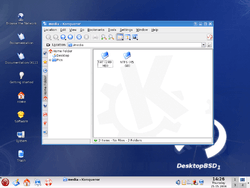DesktopBSD
|
| |
|
DesktopBSD default desktop | |
| Developer | DesktopBSD Team[1] |
|---|---|
| OS family | Unix-like |
| Working state | Current |
| Source model | Open source |
| Latest release | 1.7 / September 7, 2009[2] |
| Package manager | FreeBSD Ports |
| Platforms | IA-32 and x86-64 |
| Kernel type | Monolithic |
| Default user interface | K Desktop Environment 3.5[2] |
| License |
Several:
|
| Official website | http://www.desktopbsd.net |
DesktopBSD is a Unix-derivative, desktop-oriented operating system based on FreeBSD. Its goal is to combine the stability of FreeBSD with the ease-of-use of K Desktop Environment 3.5, which is the default graphical user interface.
History and development
DesktopBSD is essentially a customized installation of FreeBSD and is not a fork of FreeBSD. DesktopBSD is always based on FreeBSD's latest stable branch but incorporates certain customized, pre-installed software such as KDE and DesktopBSD utilities and configuration files.
A common misconception about DesktopBSD is that it is intended as a rival to PC-BSD as a BSD-based desktop distribution, since they are similar in structure and goals. However, the DesktopBSD project was started approximately one year before the PC-BSD project, despite the fact that the first PC-BSD release came out before DesktopBSD's. Neither the DesktopBSD nor PC-BSD projects intend to rival each other and are completely independent projects with distinctive features and intended outcomes: e.g., DesktopBSD uses ports and packages for additional software installation, whereas PC-BSD introduced PBIs.
The current release is 1.7 which was made available on September 7, 2009. The release announcement stated "This is the last and final release of the DesktopBSD project" because the lead developer could no longer contribute the time required to maintain it.[5] As of May 2010 development of DesktopBSD has been restarted under new leadership.[6] Development and announcements stopped soon afterwards, leading to speculation that the project had been dropped again. However, on 10 March 2013, a forum post appeared announcing that the project was "in the process of being revived."[7] The roadmap for DesktopBSD 2.0 was announced in September 2015 on the DesktopBSD site, along with posted screenshots of a GNOME3-based desktop.
Graphical features
- Installer allowing to partition disks and create users
- Tool for managing, installing and updating software using FreeBSD ports system
- Management of network interfaces and mounting/unmounting drives
1.7 release
The 1.7 release includes
- FreeBSD 7.2 as base system
- OpenOffice.org 3.1.1 as feature-rich office suite
- Pre-installed Java SE 6 environment
- X.Org release 7.4 with extensive graphics support
- Large number of enhancements, fixes and minor software updates
- Supports GRUB bootloader on i386 and includes a graphical configuration tool
On 7 September 2009 DesktopBSD 1.7 was made available on the project site.[8]
See also
References
- ↑ "DesktopBSD Team Members". desktopbsd.net. Retrieved 2010-04-01.
- 1 2 "DistroWatch: DesktopBSD". distrowatch.com. Retrieved 2011-10-18.
- ↑ "DesktopBSD Artwork Collection". desktopbsd.net. Retrieved 2008-03-20.
- ↑ "KDE Licensing Policy". KDE TechBase. Retrieved 2010-04-01.
- ↑ "DesktopBSD 1.7 available". desktopbsd.net. 2009-09-07. Retrieved 2009-09-27.
- ↑ "Advancement of the DesktopBSD project". 2010-05-30. Retrieved 2012-08-21.
- ↑ "Welcome to DesktopBSD forums". 2013-03-10. Retrieved 2013-03-21.
- ↑ "DesktopBSD 1.7 release notes". desktopbsd.net. 2009-09-07. Retrieved 2011-10-18.
External links
- Official website
- DesktopBSD 1.0 release notes
- BSDTalk Interview with Peter Hofer (DesktopBSD developer/mp3)
- DesktopBSD flyer Info from AllBSD.de (pdf/English)
- Using DesktopBSD Dru Lavigne
| ||||||||||||||||||||||||
